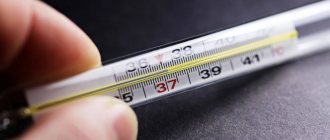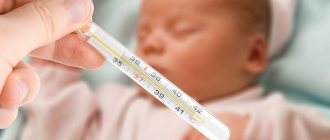A dry cough and elevated body temperature are reasons to suspect you have coronavirus. Scientists continue to study the symptoms, features of the course and possible complications of the new disease. Available data on changes in body temperature during coronavirus make it possible to clearly formulate indicators characteristic of the asymptomatic course of the disease, mild and severe.
What temperature can there be with COVID-19?
The body reacts to infection by raising body temperature. When the new COVID-19 virus first appears, your body temperature changes. Hyperthermia (or hypothermia) appears 2-7 days after exposure to the virus.
The duration of the condition is influenced by the immune status of the infected person, the presence of chronic health problems and the severity of the disease.
The individual characteristics of the body determine the course of the disease:
- asymptomatic, maintaining good health;
- with a slight increase in temperature: from 37.2 to 38°C;
- with an increase above 39°C. May be accompanied by severe weakness and fever, possible lung damage. Hospitalization to a hospital is indicated.
The vast majority of coronavirus patients reported temperatures in the range of 37.1 – 37.9°C.
Some of the infected complained of a sharp increase in the temperature to 38 °C or more.
If complications occur, 5-6 days after the first signs appear, the temperature may rise to 39°C.
Depending on how you feel, try not to take antipyretics when the reading is below 38.5 °C. Consider your general health and your doctor's recommendations.
The disease can progress in different ways, so it is important to measure your temperature every day for the first 14 days. The thermometer readings are recorded in a notepad. Carefully monitor your health for a month after the onset of the disease in order to identify possible complications in time.
If the disease is asymptomatic, the temperature may be within normal limits or rise slightly to 37.2°C for several hours, followed by normalization.
The temperature during coronavirus may be lower. This occurs when the immune system becomes tolerant to viral interference. The body does not give an immune response and does not consider the infection to be a foreign element. In this case, the inflammatory response is not present, and interferon is not produced in sufficient quantities.
Due to the depletion of the immune system by the fight against COVID-19, after the fever stage, a short-term decrease in the indicator below 36 ° C is possible.
In children, coronavirus can also be asymptomatic, with an imperceptible rise in temperature to 37.2°C. Rarely is it possible to reach 38.5°C. However, in children weakened by frequent ARVI or with chronic diseases, the thermometer mark can reach 40°C. There is a risk of developing breathing problems and pneumonia.
Fever without symptoms: what to do
Sometimes there may be no symptoms of fever: no cough, headaches, runny nose, fatigue or chills. Fever without symptoms can occur in two cases: fever without a source of infection and fever of unknown origin.
Fever without a source of infection affects children under 3 years of age who do not have catarrhal symptoms (runny nose, cough, sputum) and other signs that indicate the cause of the pathology and its location. Fever without a focus of infection occurs with viral and bacterial diseases, most often with pneumococcal infection, Haemophilus influenzae, typhoid and salmonella. In this case, you need to show the child to a pediatrician or call an ambulance, as it is necessary to quickly establish the cause and begin treatment.
Fever of unknown origin is a syndrome in which fever (38.5 0C and above) does not go away on its own and lasts longer than 3 weeks. However, the cause could not be determined after using routine diagnostic methods. Probable causes: infections (most often tuberculosis), autoimmune diseases, malignant neoplasms, medications, alcoholic cirrhosis, Crohn's disease. If you have a fever of unknown origin, you need to see a doctor and be hospitalized so that doctors can monitor the patient constantly.
How many days can a high temperature last?
The duration of the period of temperature fluctuations directly depends on the severity of the disease:
- In uncomplicated cases, hyperthermia is observed in the first 7 days. The thermometer does not reach 38°C and easily gets lost.
- In severe cases, there is a sudden jump to 39.5–40° C. There is no effect from taking antipyretic drugs.
If coronavirus infection is complicated by pneumonia, high temperatures will persist for up to 21 days. Low-grade fever may persist for another 21-30 days after negative tests for the virus.
In young children, high fever (38–39°C) can last up to three days. May be accompanied by chills, headache, and nausea. Subsequently, there is a gradual decrease.
However, in most cases, coronavirus is not accompanied by hyperthermia: for 2-3 days the temperature is in the range of 37.2–38°C, and then drops to normal.
What can cause a fever?
So, first, let's figure out what low-grade fever is. In the literature, this is what is called a temperature above 37.4, but below 38 degrees, although more often this concept means a fever that “hovered” at the numbers 37.3 - 37.7, and we are not talking about a one-time increase in temperature, but about regular disturbances in the temperature curve. Another feature of low-grade fever is that most often a person does not feel his temperature, that is, he does not have the symptoms that we often experience when the numbers increase:
- headache;
- chills or fever;
- aching bones;
- weakness;
- sweating
He may feel well, go to work, live a normal life and experience only weakness and malaise. Often a person finds out about his low-grade fever by accident when he decides to take his temperature.
Temperature measurement: how and how to do it correctly
To detect elevated temperature, several types of thermometers are used:
- Mercury. Used in hospitals, it is considered one of the most accurate, and is easily disinfected. But it contains a dangerous substance and is fragile. The measurement error is 0.1°C. The procedure will take 5-10 minutes.
- Electronic. Allows you to find out the result in 1-3 minutes. The device can carry out thermometry in the armpit, rectum or oral cavity. Disinfection before use is required.
- Infrared. They have an error of 0.5-1 degrees. Easy to use: non-contact and provides results in 5 seconds. Most often used when measuring the temperature of a large number of people.
Mercury thermometers are the most affordable (from 150 rubles). Rules for using a mercury thermometer:
- Spray with disinfectant and shake the thermometer. The mercury should drop below 35.5°C.
- The armpit should be wiped dry with a napkin.
- Place the thermometer under the armpit, ensuring a snug fit.
- Press your forearm to your chest.
- It is advisable to hold it for 10 minutes, and then evaluate the result.
When using an electronic thermometer, it is important to ensure a tight fit of the sensor to the body, and after the signal, hold the device in the armpit for another 2-3 minutes. Change the batteries in the electronic thermometer in a timely manner to avoid unreliable measurements.
What temperature needs to be lowered?
Experts advise resorting to antipyretic drugs only when the readings on the thermometer reach 38.6 degrees. In fact, there is no need to panic, since such an increase in temperature is only necessary for the body to suppress the infection.
Using this method, the body reports that it is actively counteracting the disease and fighting viruses. The body can cope with most viruses on its own, so it is not always worth interfering with this process.
It is necessary to sensibly assess the situation and make sure that your actions do not harm the body. If the thermometer already shows 39.3 or more, you need to urgently call and call an ambulance.
What to do if you have a high body temperature due to coronavirus
When detecting elevated body temperature, it is important to follow the following recommendations:
- Avoid overheating a sick person (if it’s hot, you don’t need to bundle up or dress warmly).
- If you have chills and cold extremities, you can additionally cover yourself with a warm blanket.
- Ventilate the room regularly.
- Keep the air in the room humid. Use a humidifier or hang wet towels on radiators. Bowls of water placed on surfaces will also work.
During hot weather, an enhanced drinking regime is important: drink as much non-carbonated mineral water, rosehip decoction, dried fruit compote, and herbal teas as possible.
How to bring down the temperature
It is necessary to reduce the temperature in the correct way.
- If you are planning to fight a fever, it is important to remember that the person should be wearing as little clothing as possible. Excessive “wrapping up” will only aggravate the situation. Except for those moments when a person feels chills.
- When a person gets sick and develops a fever, it is important to understand that it is strictly contraindicated for him to stay in hot water for a long time, as well as in a bathhouse and sauna.
- Doctors do not advise lowering the temperature with aspirin and similar means. This is ineffective, and sometimes the use of aspirin can contribute to diseases associated with the kidneys and liver. Therefore, if necessary, use antipyretics.
Some people believe that fever can be reduced by drinking certain alcohol tinctures. However, this is absolutely not true, since alcohol guarantees an increase in pressure inside the vessels, which certainly will not reduce the temperature.
Thus, it is not always worth hastily trying to get rid of a high temperature. Consider all the options and consequences, or better yet, consult a clinic.
ONLINE REGISTRATION at the DIANA clinic
You can make an appointment by calling the toll-free phone number 8-800-707-15-60 or filling out the contact form. In this case, we will contact you ourselves.
Reasons for rising temperature
An increase in temperature is always a sign of an inflammatory process occurring in the body. In ARVI, hyperthermia is accompanied by symptoms characteristic of this disease associated with weakness, nasal congestion and cough. But besides a cold, fever can also occur under other circumstances.
The normal level is 36.6˚C. But this indicator is not mandatory. There are people whose body temperature in a healthy state differs from the average statistical norm: for some it is 35.5, and for others 37.2. In addition, a child’s body temperature of 37.3˚C up to three years of age is considered normal, if there are no complaints.
Reasons for rising temperature:
- ARVI;
- Bacterial infection (infectious disease);
- Intestinal infections, as well as poisoning;
- Overheating (heatstroke);
- Teething period;
- The body's reaction to the administered vaccine;
- Nervous tension;
- Disturbances in the functioning of the endocrine system.
Another cause of fever, especially common in children from two to seven years old, is sudden exanthema. This is a viral disease that is rarely diagnosed in modern medicine. The disease begins with hyperthermia, which reaches 39˚C and lasts up to 4 days. On the day when the temperature no longer rises, the body becomes covered with a red rash. Mainly the back, shoulders and stomach. The rash goes away on its own and does not require treatment. Due to the fact that when the temperature rises, a person manages to drink an antipyretic drug several times, the rash is regarded as an allergic reaction to the drug. But such symptoms are a viral disease, which is also called Roseola.
High temperature in an adult
Severe fever may occur briefly when overheated, but the symptom quickly resolves after taking antipyretics. If the thermometer readings stay within 40°C for a long time, this indicates an acute pathological process and requires examination to determine the cause.
When an adult has a temperature of 40, it needs to be brought down by drinking an antipyretic or using home methods. Prolonged fever exhausts the body and can cause complications.
Why is temperature dangerous?
What is the danger of temperature?
Most of all, parents are afraid of fever, that is, an increase in body temperature in children.
We have collected several options for “threats” that are used to scare parents if the temperature on the thermometer rises above “critical levels”:
- The protein will coagulate
- The brain will overheat
- Convulsions will begin
- The child will “burn out.”
What's in reality?
An increase in temperature (fever) is a protective mechanism of the human body while fighting infection. The body is able to control this process and it will not be able to harm itself.
A safe increase in body temperature is considered to be up to 42 degrees. And the protein will not coagulate. It is impossible to boil an egg at this temperature.
Let's give an example: almost all housewives have an oven in their kitchen; To prepare a pie, a temperature of 180 degrees is required, for cooking fish or meat - 200-220 degrees. You set this temperature yourself and the oven will not overheat or break.
The same goes for the body: joining the fight against viruses and bacteria, the immune system (housewife) begins to produce pyrogen substances (oven mode switches). Under their influence, the hypothalamus (oven) increases the temperature from normal to 39-40 degrees.
This is required to increase the efficiency of immune mechanisms, to produce acute phase proteins (C-reactive protein, procalcitonin), which destroy pathogens. Microbes will also have difficulty reproducing at this temperature.
After the number of bacteria and viruses in the body has decreased, pyrogens cease to be produced and stimulate the hypothalamus, body temperature returns to normal 36-37 degrees.
Is it necessary to fight “white fever” and give No-shpa?
To increase the temperature, the body activates its forces, reducing heat loss: a spasm of peripheral vessels occurs, the limbs cool, the skin turns pale, trembling and chills occur.
In the post-Soviet space, it was customary to call this stage of fever white and try in every possible way to turn it into red. This term is not available in international sources; it is believed that this is only one of the mechanisms/stages of temperature increase.
No-spa is not needed in this case, since its action is aimed at the smooth muscles of internal organs, and not blood vessels.
Febrile convulsions at high fever.
They occur in approximately 2-5% of children aged 6 months to 5 years, usually peaking between 12-18 months of age.
The development is typical on the first day of the disease, when the temperature rises sharply to 38-39 degrees, the duration of seizures is up to 15 minutes (usually up to 5 minutes), and ends in sleep.
They are benign in nature, do not require treatment and do not recur the next day.
They arise due to the immaturity of the central nervous system of babies, and then children outgrow them.
Please note that drinking antipyretics is not effective for prevention.
When should you lower your temperature?
It is necessary to monitor the child’s condition: when he is very ill, his muscles and joints, head and ears hurt, then we must give an antipyretic for pain relief, regardless of what the thermometer shows.
What drugs can be used?
Paracetamol and ibuprofen are the only ones.
In order to get the effect of the medicine, you need to create cool and moist air in the room, it is important to keep the child hydrated (avoid dehydration).
The child’s immune system should be able to fight viruses and bacteria; do not interfere with this by uncontrollably giving antipyretics.
Temperature 39 C
Hyperthermia 39 is no less dangerous than 40. Prolonged heat leads to dehydration, disrupts salt balance and can provoke such a dangerous complication as cerebral edema.
In an adult
A temperature of 39 without symptoms in an adult may be a consequence of an exacerbation of latent chronic inflammation. Less commonly, fever occurs due to nervous feelings or overheating.
There is no need to endure a fever for a long time if the thermometer reading remains at 39. The safe temperature threshold when the body is fighting the cause of the disease is 38.5 ° C; if the temperature rises higher, complications may arise.
The child has
In children, fever is often the initial sign of a cold. With a weakened immune system, cough, runny nose and other signs of the disease may appear only on 2-3 days. In babies, a temperature of up to 39 occurs during teething or develops after vaccinations.
High temperatures can cause hyperthermic seizures.









